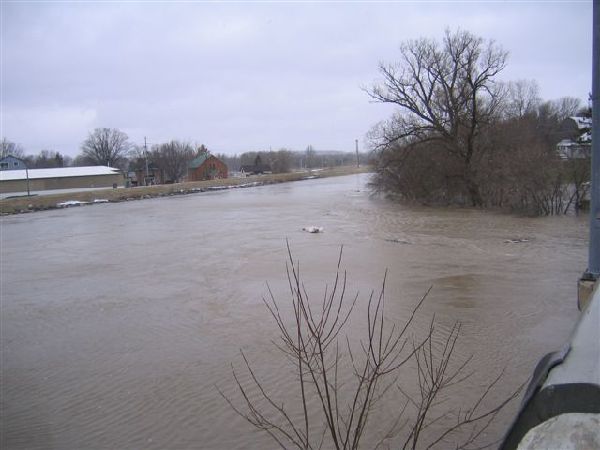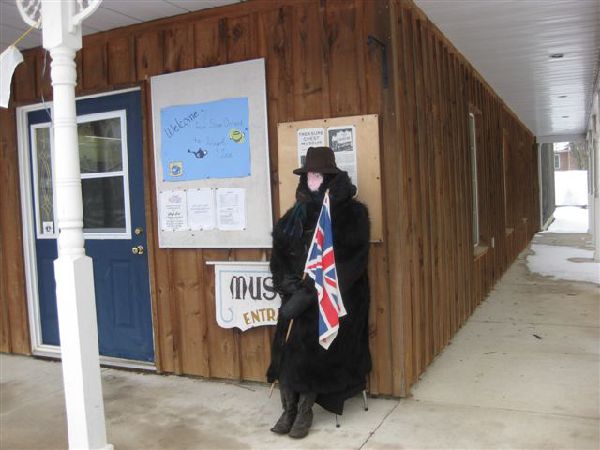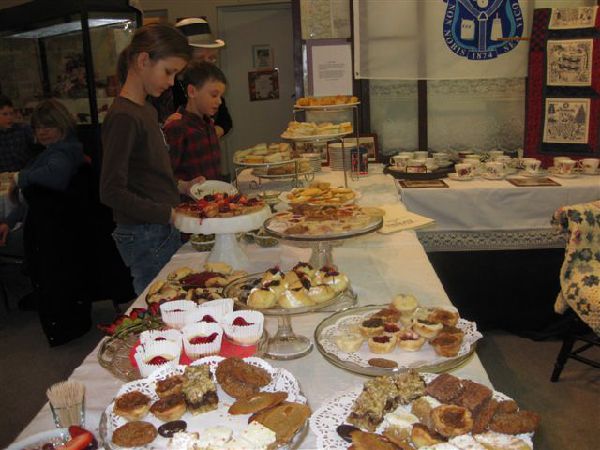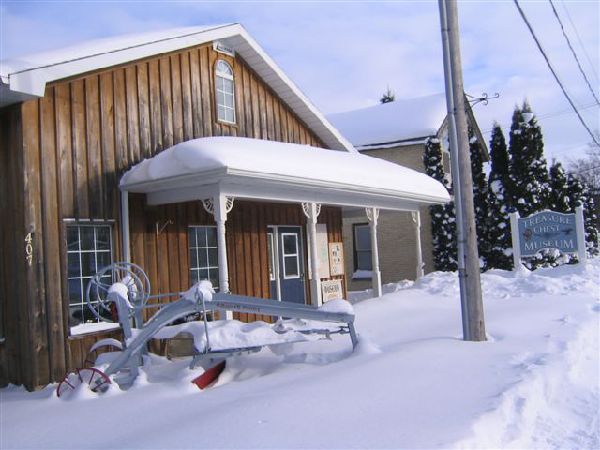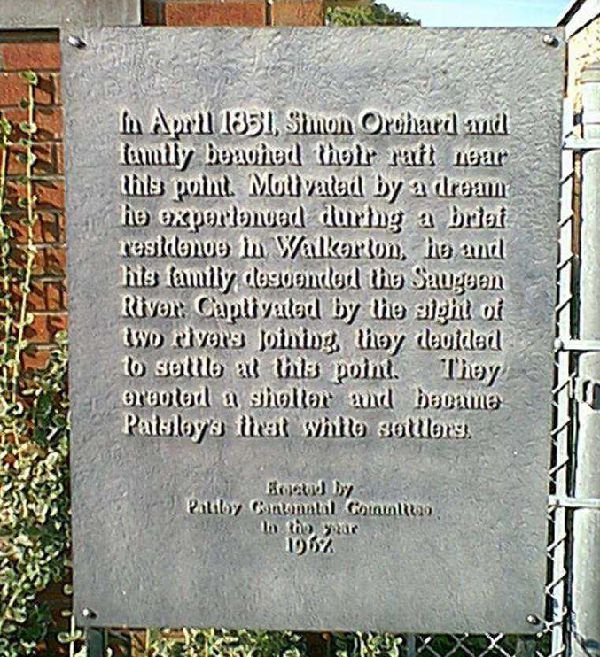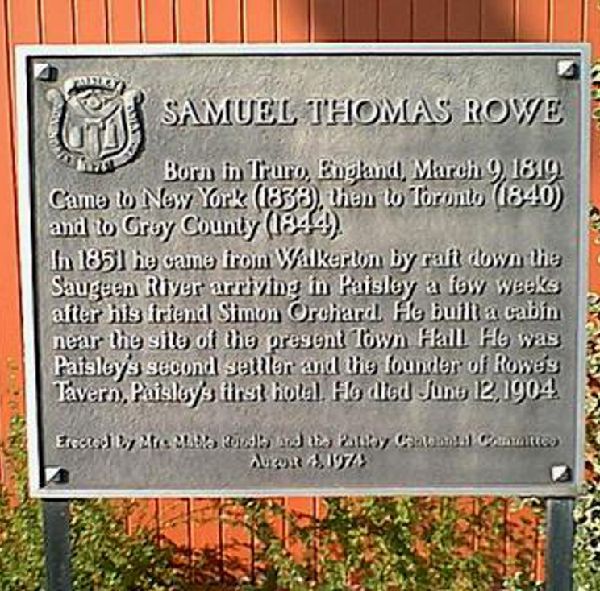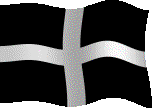- From the Old World to the New
So many pioneer families made a great contribution to the Canadian landscape. One such family named Orchard, came to the area of Grey County, Ontario, in late 1841. Their story is not without many hardships.
Thomas & Betsy (Wilton) Orchard decided to leave Week St. Mary seeking a new life in the new land. They had ten children ranging in ages from 6-26 years. Possibly they thought of finding better opportunities for their family. Thomas Orchard was 53 years of age, while his wife was 43. It took between two and three months for them to cross the Atlantic Ocean, and it is thought they landed at New York. Father was not well when they landed, however, travelling from New York to Cleveland by stagecoach. Thomas Orchard passed away at Cleveland and was buried there just two weeks after their arrival.
This must have been a shock to the family, but, determined to gain a foothold in the new land, they pressed on to Toronto.
John Orchard, the eldest son who had been a war veteran, made arrangements here to receive a land grant. With this grant of 100 acres there was a stipulation that he should build an inn or hotel about half way between Mount Forest and Durham, then known as the Maitland Hills and Bentick settlement. Elizabeth Orchard (Betsy) the widowed mother also claimed her lots, divison l of Lot 14 Concession 1 Egremont.
A settler was required to build a cabin or log house and make certain noticeable improvements such as clearing the land for a period of five years before receiving the patent or Crown Deed.
Thus sprang up the community of Orchardville. It was situated on the old Garafraxa trail, being the boundary line between the Townships of Egremont and Normanby.
Charles Rankin was instructed to survey a line from the Fergus settlement to Owen Sound then known as Sydenham Settlement. The survey was temporarily stopped with the outbreak of the Mackenzie Rebellion in 1837. Then the Government thought that Rankin's survey was too crooked and too long, so sent John McDonald to re-survey it in 1841. About the only difference made in this area was that instead of going West of the 40 mile long swamp as Rankin had done, McDonald came through the centre of it. McDonald also surveyed farm lots on both sides of the Garafraxa trail.
Each Lot was comprised of three divisions of 50 acres. Settlers who came into this area immediately after the survey had the choice of one 50 acre division. The one beside the 50 acre was held in reserve for a few years. These first lots were soon claimed. It was noted that John was the only one to receive two fifty-acre lots side by side. He acquired the crown deeds to the same in 1846 and 1847.
After receiving the lots, they then travelled back to Hamilton and north to Guelph by stagecoach. They were known to have friends in Eramosa Township. As autumn was fast approaching, it is assumed that once Elizabeth and her two older sons had laid claim to their land, that they would have travelled back to the Guelph area for the winter. The whole family then moved to the area in the Spring of 1842.
John Orchard claimed another 50 acres between his original and his mother's in 1842. He lived in Eramosa Township from 1843 to 1856 and married Sarah Parkinson. John had a village site surveyed off the front of Div. 2, lot 13, con.1 Egremont in 1858, consisting of 12 quarter-acre lots and two streets that he named after his sons, John and Thomas. A two-acre lot was also set aside then, for a fair ground on the north-west corner of div. 3 lot12. Eight more lots were surveyed off the front of Div. 3 in 1876.
A Post office was established in 1847. At first the name was Normanby but later changed to Orchardville but that name was too long for the stamping hammer so was changed to Orchard, July 1st, 1862. This name still exists in 2007. John passed away in 1872, age 65 years.
School was the next priority. A school property was taken off the mother's farm. It was called U.S.S. #2, Egremont and Normanby, otherwise known as the Orchard school. In 1849, Simon, as one of the trustees, beseeched the government for funds to pay a Teacher. The brick school one sees on Highway #6 was built in 1902.
Another daughter, Mary-Ann, married Samuel Rowe, from a neighbouring farm. He had come out from Truro, Devon.
Later, in 1851, these two families, Simon Orchard and Samuel Rowe became the first settlers to establish Paisley. When the two families left the area of Orchard, Simon sold his farm of Div. 3, lot 14, con.1 Egremont. Samuel rented out his land, across the road in Normanby.
Simon had been born July 26, 1823, at Kitsham, Week St. Mary. He was about 18 when he had left England. He had married Lily-Ann born July 20th, 1823 in Scotland. It is stated that he was a 'Yeoman'.
Simon & Lily's first child was born in 1847, named Eliza Jane. A second child was also born in Egremont, initials M.A., in1850. We wonder why Simon and Samuel made the decision to come down the Saugeen River back in 1851, to seek new lands. However, the land in Bruce County was just being opened up. Perhaps it was the sense of a new adventure. Maybe it was the stories of the fertile land in this area of the Bruce. However, the men took their belongings over in the winter of 1851, to Walkerton. They brought their families in the early Spring and then prepared to set sail on rafts down the river once the ice was gone.
- Before the Surveyors Ever Ran Their Line
Standing upon the Main Street Bridge in Paisley, Ontario, Canada, it is very fascinating to watch the fast flowing swollen waters of the Saugeen River in springtime. That must have been some trip coming down the river on a raft from Walkerton back on April 18th, 1851! What a brave family to attempt this journey into the wilderness of the Queen's Bush. The Orchard family had left their home in Orchardville, just nine miles or so, south of Durham, in Egremont, Grey County. Their belongings had been taken by sleigh that winter to Walkerton. They had come over later in the Spring preparing to navigate this large River in hope of finding better land. A large 30ft x 15ft. cedar log raft was built by some French Canadian loggers in the area.
With their possessions stored in trunks, a meagre amount of furniture, a Family Bible, and provisions of food purchased at Walkerton were all stacked on the raft. As well, there were the few necessary tools given to early settlers by the Canadian government in order to make a start on the land and to build a home.
As night was descending, they watched anxiously for a place to rest for the night. No wonderful motels in this land! Eventually, they saw a large elm tree at a bend in the river, which just seemed to beckon them. They drifted to the north bank, tied up their raft, and climbed ashore. The big tree later became known as the Tidings Tree only dying in recent times (1968). The location was also near by the present day Baptist church. They had brought a few planks from Walkerton and thus set about to make a lean-to for the night. This may have been an adventure for the family but after having left the few comforts of a log cabin, this must have seemed very primitive! Simon and Lily Ann, his wife, and small child made the best of the situation. Upon rising the next morning and seeing the beautiful trees and flat valley he decided that the area was a desirable place, at the confluence of the two rivers. Simon decided to make this their destination, to begin life anew. As you now know, this was the beginning of Paisley.
A few days later, along came some surveyors, led by Alex Videl, who were blazing a new road from the Durham Road, north to Southampton. This later became known as the Elora Road, and today as Bruce County Road #3.
“Sure we will give you a hand to build you a cabin. We see you have been busy chopping logs in readiness,” Vidal told Simon.
Yes, Simon was so thankful to find this location, a place of which he had dreamed! “For sure, my brother John is happy with his grant of 100 acres, but look what I have, fresh water, an abundance of fish, good soil, large trees, and NO stones! I even beat the surveyors as well!”
“Well, my dear Mary-Ann, it is already May 9th 1851. Time to leave Walkerton. I know it is sad to leave behind the precious memories of our beloved wee son. We did all we could to help him here. Cousin Jasper's two-story log home has been set up. He has in turn helped us to build our large rafts for this journey. The cattle are being loaded on one.
Your brother Simon will be wondering when we are coming. It has been three weeks since we saw him leave. Word has been received that it will take most of the day to make the trip to where Simon and family have chosen to settle. I am counting on his good judgement that he has found the best land. However, I have only rented my farm back in Normanby, so if we choose, we could go back.” Those were the words spoken by Samuel Rowe as he and his young family prepared for this perilous journey down the Saugeen River.
They had two experienced hardy river drivers from the Ottawa Valley to help with the rafting. The river was high. It almost proved too much for these drivers. However, the important cargo of travellers, with provisions, including flour and salt pork, along with their cattle, survived the hazardous journey. The day was overcast, cold and dreary. How grateful they were to see Simon and family waving to them as they rounded another and final bend. A warm cheery fire awaited them in Simon's cabin. They agreed that Samuel would set up house-keeping on the south shore.
Yes, Simon had made a good choice. This did indeed seem a worthy site. With the help of oxen, a log shanty was built where the Paisley Inn now stands. Although the families were separated by the Mud River (later called the Teeswater River) and the Saugeen River, the men undertook to build a foot-bridge. When it washed out the following Spring, a dog called Danger was trained to swim across, to carry small items from one shanty to another.
Samuel and Simon knew they had to get official permission to own the land where they had settled. They saw the possibilities of setting up a town here. In desiring to secure a patent from the Crown they paid early into the hands of the Crown Land Agent the required amount. It seems that others in the political field thought the same thing.
Were they speculating? The Crown patent remained un-issued year after year. Mr. Rowe made repeated visits to the Crown Land Department at Quebec and Toronto. Finally in 1856, Francis Kerr, P.L.S. decided to have a town plot laid out and made the necessary survey. Rowe's and Orchard's rights were respected. Thus, patent after patent in their names were issued September 17th, 1856, creating village and parking lots which were entered in the books of the Registry Office.
Exciting times lay ahead for Simon Orchard and Samuel Rowe. First Samuel Rowe erected a log building, called Rowe's Tavern, near to the present day site of the Paisley Inn.
During the Land Sale at Southampton in 1854, Mrs. Rowe was said to have cooked a whole ox along with potatoes. In two days it was all gone, as so many people had passed through on their way to Southampton.
In 1853, Thomas Orchard (born:1830; married: Christina Brown in 1850), Simon's younger brother, moved from Orchard in Grey County to Paisley and established the first store, supplying hardware, dry goods and groceries etc.
Thomas Orchard also opened the first Post Office, becoming the first Postmaster. Many names were suggested for naming of this new village, but the Government selected “Paisley” after a town in Scotland. During this time in Paisley he was the 1st Postmaster, Justice of the Peace, and also served on the Council. He lived 16 years in Paisley before moving to Carrollton, Missouri USA in 1869.
The first municipal council of Elderslie township, of which Paisley was a part, met on January 22,1856 in Rowe's Tavern, Paisley. Samuel T. Rowe was elected as first Reeve. Streets were named after the battles of the Crimean War, being the war was just over. Balaclava, Inkerman and Alma being some of the names used.
Later Paisley was organized as an urban Municipality on January 19th, 1874. The Town Hall, built to hold the Municipal offices, was opened in 1876.
Samuel Rowe donated land for the erection of the Anglican church which opened in 1864. You can see a plaque inside the church on the wall remembering the Rowe Family. He also donated land for the Agricultural Park where the Fair is held each year.
There are a few homes in Paisley that Samuel Rowe built, that still stands today. One is a Bridal home on Albert St. that he built as a wedding gift for daughter Julia.
Simon Orchard was known as a builder of bridges and of laying out roads in all directions from Paisley. Simon also established a trail to Port Elgin in the very early times. He was paid to help chop the trees on roads leading to Paisley.
These men worked hard to make this settlement in the wilderness become what it is today. Simon passed away in 1873 at the age of 50. He had lived to see the first train come to Paisley in 1872. This would have truly been a big event in his life.
Samuel, who was born in Truro lived to be a ripe old age of 85, passing away in 1904. Both men were considered to be very kindly and helpful to the early settlers.
Today (2007), there are plaques to honour these first settlers in front of the Paisley Library. You can also see their tombstones in the Paisley Cemetery, where details of their life are found inscribed upon the granite or limestone.
They are not to be forgotten, no matter how far from home they roamed!

